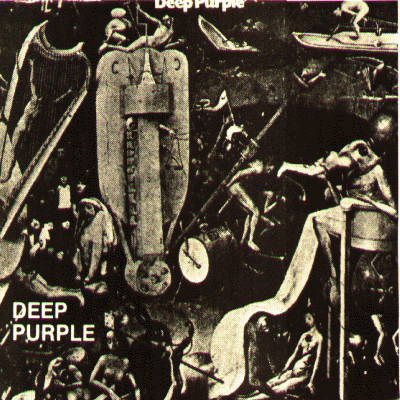 |
From the Vault...
07/25/1999
#639 |

|
info
Deep Purple
"Deep Purple"
© Creative Sounds Ltd. Rec
Year of Release: 1969
Rating:



|
track listing
|
Chasing Shadows
Blind
Lalena
Fault Line
The Painter
Why Didn't Rosemary
Bird Has Flown/April
|
WSVNRadio Archives
Deep Purple related sites:
|
|
|
Deep Purple
"Deep Purple"
Deep Purple's third album released in 1969, the self-titled Deep
Purple, would feature the band's original lead singer, Rod Evans, for
the last time. A huge personnel change would occur after this release, as
this new lineup would be the ultimate Deep Purple. But for this review, we
take a look at what would be the actual ORIGINAL lineup of Deep Purple, where
keyboardist Jon Lord, and the band's primary leader, guitarist Ritchie
Blackmore, would be the only members who would remain after the peronnel
lineup change.
"Chasing Shadows" has the "run through the jungle" beat; that is,
it is more of an African-beat-driven song. "Blind" and "Lalena"
definitely have the late 1960s sound, as they are slow/medium tunes. They're
both a cross between songs by either The Moody Blues and/or Emerson, Lake &
Palmer.
"Fault Line" and the next two songs on this album have the sound
where Deep Purple is most famous for: hard rock, with its guitars and keyboard
dominations. If you're familar with DP's songs "Wring That Neck" a.k.a.
"Hard Road" -- when you hear "The Painter", it has the familar
main verses. "The Painter" has vocals, and though it's not exactly like
"Hard Road" as such, there are some changes in the song, as compared to
the rocking instrumental. But you can't help pointing out the fact that
"The Painter" has its similarities to "Hard Road", (which is
the title that I am most familar with).
"Why Didn't Rosemary" starts out with the typical 1960s psychedelic
rock, and right around the four-minute mark, it features a more progressive
sound, featuring keyboards, followed by the rest of the band.
According to the listing of songs, the last two songs are "Bird Has
Flown" and "April". But, there are only 7 songs on the CD.
(Perhaps this 11-minute song is a medley of these last two titles?) Of the
two titles, "Bird Has Flown" is the better one; as this song is much
slower than the previous rockers, and has a progressive rock sound.
The song is mostly instrumental, as keyboardist Jon Lord features the
church-type organ as the song's intro, as the rest of the band demonstrates
a more mellow approach throughout the rest of the song. Towards the end, it
turns into a beautiful classical music piece (maybe this is the track
"April"). At around the 9 minute mark, it returns to rock with vocals.
"Bird Has Flown" is very impressive. With its title, it has the
atmosphere of a bird flying for freedom. (And speaking of classical music,
Deep Purple would later record a live classical album, Concerto for Group
and Orchestra, in 1970).
Deep Purple is a good album. The vocalist may not ring a bell for
those die-hard Deep Purple fans, but this was the beginning foundations of a
band that would later become one of the best hard rock/heavy metal groups
to emerge throughout the Seventies through the Nineties. Despite its many
personnel lineup changes (yes, again), the main focus of the band is guitarist
Ritchie Blackmore, who, along with various lead singers (Ian Gillan and David
Coverdale) would crank out some great albums during the last 30 (!) years,
as Deep Purple remains one of the greatest bands ever in rock.
If you haven't discovered the early years of Deep Purple (1968-1970),
their early albums will not be a disappointment. It's great to hear a band's
early albums, and how they progressed to their most famous ones.
© WSVNRadio.net. All rights reserved.
Review or any portion may not be reproduced
without written permission. Cover art is the
intellectual property of
Creative Sounds Ltd. Record
and is used for reference purposes only.
|
|





